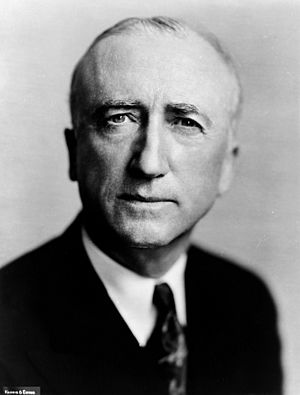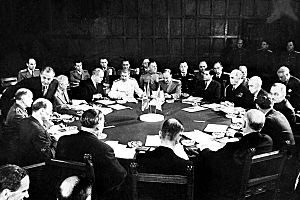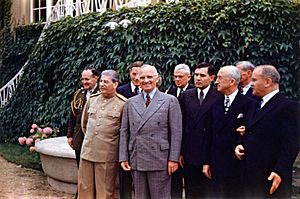James F. Byrnes facts for kids
Quick facts for kids
James F. Byrnes
|
|
|---|---|
 |
|
| 104th Governor of South Carolina | |
| In office January 16, 1951 – January 18, 1955 |
|
| Lieutenant | George Bell Timmerman Jr. |
| Preceded by | Strom Thurmond |
| Succeeded by | George Bell Timmerman Jr. |
| 49th United States Secretary of State | |
| In office July 3, 1945 – January 21, 1947 |
|
| President | Harry S. Truman |
| Preceded by | Edward Stettinius Jr. |
| Succeeded by | George Marshall |
| Director of the Office of War Mobilization | |
| In office May 27, 1943 – July 3, 1945 |
|
| President | Franklin D. Roosevelt |
| Preceded by | Position established |
| Succeeded by | John Wesley Snyder |
| Director of the Office of Economic Stabilization | |
| In office October 3, 1942 – May 27, 1943 |
|
| President | Franklin D. Roosevelt |
| Preceded by | Position established |
| Succeeded by | Fred M. Vinson |
| Associate Justice of the Supreme Court of the United States | |
| In office July 8, 1941 – October 3, 1942 |
|
| Nominated by | Franklin D. Roosevelt |
| Preceded by | James Clark McReynolds |
| Succeeded by | Wiley Rutledge |
| United States Senator from South Carolina |
|
| In office March 4, 1931 – July 8, 1941 |
|
| Preceded by | Coleman Livingston Blease |
| Succeeded by | Alva M. Lumpkin |
| Member of the U.S. House of Representatives from South Carolina's 2nd district |
|
| In office March 4, 1911 – March 3, 1925 |
|
| Preceded by | James Patterson |
| Succeeded by | Butler Hare |
| Personal details | |
| Born |
James Francis Byrnes
May 2, 1882 Charleston, South Carolina, U.S. |
| Died | April 9, 1972 (aged 89) Columbia, South Carolina, U.S. |
| Political party | Democratic |
| Spouse |
Maude Busch
(m. 1906) |
| Signature | |
James Francis Byrnes (May 2, 1882 – April 9, 1972) was an important American judge and politician from South Carolina. He was a member of the Democratic Party. Byrnes served in the U.S. Congress and on the U.S. Supreme Court. He also worked in the executive branch, most notably as the 49th U.S. Secretary of State for President Harry S. Truman. Byrnes was also the 104th governor of South Carolina. This makes him one of the few politicians to hold high positions in all three parts of the U.S. federal government, while also being active in state government.
Born in Charleston, South Carolina, Byrnes became a lawyer. He was elected to the U.S. House of Representatives and served from 1911 to 1925. He became a close friend of President Woodrow Wilson. He tried to become a Senator in 1924 but lost. He then moved his law practice and prepared for a political return. He won the Senate election in 1930 and joined the Senate in 1931.
Historians have called Byrnes a very influential Southern member of Congress. In the Senate, Byrnes supported his friend, President Franklin D. Roosevelt. Byrnes helped pass the New Deal laws. He also supported Roosevelt's foreign policy against the Axis powers before World War II. However, he opposed some labor laws, like the Fair Labor Standards Act, which set a minimum wage. This law could hurt his state's low factory wages.
Roosevelt appointed Byrnes to the Supreme Court in 1941. But he asked Byrnes to join the executive branch when America entered World War II. During the war, Byrnes led the Office of Economic Stabilization and the Office of War Mobilization. He was considered as a possible Vice President in 1944, but Harry S. Truman was chosen instead.
After Roosevelt died, Byrnes became a key advisor to Truman. He was named U.S. Secretary of State in July 1945. In this role, Byrnes attended important meetings like the Potsdam Conference. However, Byrnes and Truman later had disagreements. Byrnes resigned from the Cabinet in January 1947. He returned to politics in 1950, becoming the governor of South Carolina. As governor, he opposed the Supreme Court's decision in Brown v. Board of Education. He tried to keep schools "separate but equal" instead of allowing desegregation. Even though he stayed a Democrat, he supported most Republican presidential candidates after 1948.
Contents
Early Life and Start in Politics
Byrnes was born in Charleston, South Carolina. His father died shortly after he was born. His mother, Elizabeth McSweeney Byrnes, was a dressmaker. At 14, Byrnes left school to work in a law office. He became a court reporter, writing down what was said in trials. In 1906, he married Maude Perkins Busch. They did not have children.
In 1900, Byrnes's cousin, Governor Miles B. McSweeney, helped him get a job as a clerk for a judge. Byrnes studied law and became a lawyer in 1903. In 1908, he became a prosecutor for South Carolina. He served until 1910. Byrnes was a student of Senator "Pitchfork Ben" Tillman. Byrnes often helped to calm down the strong opinions of the Senator.
In 1910, he won the Democratic primary election for U.S. Representative. This win usually meant he would win the general election. He was re-elected six times, serving from 1911 to 1925.
Byrnes was a skilled lawmaker. He worked behind the scenes to bring groups together. He avoided making big speeches. He became a close friend of U.S. President Woodrow Wilson. Wilson often gave Byrnes important political tasks. In the 1920s, Byrnes supported the "Good Roads Movement". This movement aimed to build many new roads across the country.
United States Senate and Supreme Court Service
In 1924, Byrnes decided not to run for the House again. Instead, he ran for a Senate seat. He lost a close election to Coleman Livingston Blease. The Ku Klux Klan, a white-supremacist domestic-terrorist group, supported Blease. They spread rumors that Byrnes was secretly Catholic. Byrnes had been raised Catholic but had converted to the Episcopal Church.
After his House term ended in 1925, Byrnes was out of office. He moved his law practice to Spartanburg, South Carolina. He became wealthy from his law work and investments. But he still wanted to return to politics. In 1930, he challenged Blease again and won a very close election.
In the Senate, Byrnes was seen as a very important South Carolinian. He had been friends with Franklin Roosevelt for a long time. He supported Roosevelt for president in 1932. Byrnes became Roosevelt's main supporter in the Senate. He helped pass many of the early New Deal laws.
South Carolina politicians had long dreamed of a waterway system. This system would help trade and control floods. In the 1930s, Byrnes supported a huge dam project called Santee Cooper. This project would also bring electricity to the state. South Carolina was struggling during the Great Depression. Byrnes got the federal government to loan money for the entire project. It was finished in 1942. The loan was paid back, and Santee Cooper became a model for public power companies.
In 1937, Byrnes supported Roosevelt's plan to change the Supreme Court. However, he voted against the 1938 Fair Labor Standards Act. He believed a minimum wage would hurt textile mills in his state. On foreign policy, Byrnes supported Roosevelt's stance. He wanted to help the United Kingdom against Nazi Germany. He also wanted a strong approach against Japan. He spoke out against isolationists like Charles Lindbergh. Byrnes also played a role in blocking anti-lynching laws.
On June 12, 1941, Roosevelt nominated Byrnes to be an associate justice of the United States Supreme Court. He was approved the same day. He served on the Court for only 15 months. This was the shortest time for any non-incumbent justice.
World War II Contributions



Byrnes left the Supreme Court to lead Roosevelt's Office of Economic Stabilization. This office handled important issues like prices and taxes during the war. In May 1943, he became head of the Office of War Mobilization. This new agency oversaw the Office of Economic Stabilization. Under Byrnes, this program managed new factories across the country. It helped organize raw materials, civilian and military production, and transportation for the military. This work helped end the Great Depression by creating many jobs.
Because of his political experience and friendship with Roosevelt, Byrnes became very influential. He had a say in many parts of the war effort. Many in Congress and the news began calling Byrnes the "Assistant President."
Many people thought Byrnes would be the Democratic nominee for vice president in 1944. This would mean replacing Henry A. Wallace. Party officials felt Wallace was too unusual to replace an ailing president. However, Roosevelt did not strongly support Byrnes. In the end, Senator Harry S. Truman was chosen instead. Byrnes was seen as too conservative for labor unions. Some city leaders opposed him because he was a former Catholic. Black Americans were also cautious of his opposition to racial integration.
Roosevelt brought Byrnes to the Yalta Conference in early 1945. Byrnes took notes in shorthand, which became a very complete record of the meetings. After the conference, he helped convince the U.S. Congress and the public to accept the agreements made there.
Secretary of State Role
When Roosevelt died on April 12, 1945, Truman became president. Truman relied heavily on Byrnes's advice. Byrnes had been a mentor to Truman. Byrnes was one of the first people Truman met on his first day as president. It was Byrnes who told the new president about the atomic bomb project. Until then, Truman knew nothing about the Manhattan Project.
Truman appointed Byrnes as US Secretary of State on July 3, 1945. As Secretary of State, he was next in line to the Presidency. This was because there was no Vice President during Truman's first term. He played a big role at the Potsdam Conference and the Paris Peace Conference. Historians say Byrnes knew little about foreign relations, like Truman. He made decisions after talking to a few advisors.

Byrnes advised Truman that the Soviets were breaking the Yalta Agreement. He said Truman needed to be firm with them. Byrnes and British Foreign Secretary Ernest Bevin announced they were combining the U.S. and British zones of Germany. This new area was called "West Germany." Byrnes's important September 1946 speech in Stuttgart, Germany, changed American policy. It moved away from dismantling Germany's economy to rebuilding it.
Truman wanted a tough approach with the Soviet Union. But Byrnes was more willing to compromise. Their relationship became strained. Truman felt Byrnes was making foreign policy decisions without him. Truman told Byrnes he was "tired of babying the Soviets." This led to the Iran crisis of 1946. Byrnes then took a tougher stance against Stalin. He was named TIME Man of the Year. Truman believed Byrnes was showing disrespect. Byrnes felt he had to resign from the Cabinet in 1947.
Governor of South Carolina
Byrnes was not ready to stop public service. At 68, he was elected Governor of South Carolina in 1950. He served from 1951 to 1955.
Byrnes was first seen as somewhat moderate on race issues. He knew that the South could not keep its segregationist policies forever. He wanted to make changes from within the state. He tried to fulfill the "separate but equal" policy, especially for public education. Byrnes put state money into improving black schools. He bought new textbooks and buses and hired more teachers.
He also tried to limit the power of the Ku Klux Klan. He passed a law that stopped adults from wearing masks in public, except on Halloween. He hoped to make South Carolina an example for other Southern states. However, the NAACP sued South Carolina to force schools to desegregate. This led to Brown v. Board of Education, a decision Byrnes strongly criticized.
The South Carolina Constitution did not allow governors to be re-elected right away. So, Byrnes retired from politics after the 1954 election.
Later Political Life
In his later years, Byrnes believed the American South could become more important in national politics. To help this, he wanted the region to stop automatically supporting the Democratic Party. Byrnes felt the Democratic Party had become too liberal.
Byrnes supported Dwight Eisenhower in 1952. He also supported Richard Nixon in 1960 and 1968. He backed Barry Goldwater in 1964. He privately supported Senator Strom Thurmond of South Carolina when Thurmond switched to the Republican Party in 1964. However, Byrnes himself remained a Democrat.
Byrnes died at 89 years old. He was buried in the churchyard at Trinity Episcopal Church in Columbia, South Carolina.
Legacy and Impact
Byrnes is remembered at several South Carolina universities and schools:
- The James F. Byrnes Building at the University of South Carolina.
- The James F. Byrnes Professorship of International Studies at USC.
- Byrnes Auditorium at Winthrop University.
- Byrnes Hall, a dormitory at Clemson University.
- James F. Byrnes High School in Duncan, South Carolina.
In 1948, Byrnes and his wife started the James F. Byrnes Foundation Scholarships. Since then, over 1,000 young South Carolinians have received help to go to college. His official papers are kept at Clemson University's Special Collections Library.
Images for kids
See also
 In Spanish: James F. Byrnes para niños
In Spanish: James F. Byrnes para niños
- List of justices of the Supreme Court of the United States by court composition
- List of United States Supreme Court justices by time in office
- List of law clerks of the Supreme Court of the United States (Seat 3)
- United States Supreme Court cases during the Stone Court
- Oliver Stone's Untold History of the United States, Episodes 2 and 3

